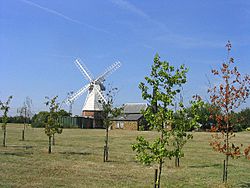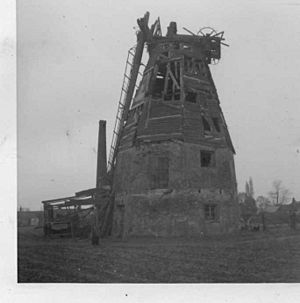Baker Street Mill, Orsett facts for kids
Quick facts for kids Orsett Mill |
|
|---|---|

The converted mill, July 2005
|
|
| Origin | |
| Mill name | Baker Street Mill |
| Mill location | TQ 633 813 |
| Coordinates | 51°30′22″N 0°21′11″E / 51.506°N 0.353°E |
| Operator(s) | Private |
| Year built | Late 18th century |
| Information | |
| Purpose | Corn mill |
| Type | Smock mill |
| Storeys | Three-storey smock |
| Base storeys | Two-storey base |
| Smock sides | Eight-sided smock |
| No. of sails | Four sails |
| Type of sails | Double Patent Sails |
| Windshaft | Cast iron |
| Winding | Fantail |
| Fantail blades | Eight blades |
| Auxiliary power | Steam mill adjoining |
| No. of pairs of millstones | Three pairs |
Baker Street Mill is a special old building in Orsett, Essex, England. It's a type of windmill called a smock mill. This means it has a wooden tower that looks a bit like a smock (an old-fashioned shirt).
Today, the bottom two floors of the mill have been changed into a home. It's a "grade II listed" building, which means it's protected because it's important to history.
Contents
The Mill's Story
People believe Baker Street Mill was built around 1765. Some records even suggest it might have been built in 1762. The first clear mention of the mill was in 1796.
The mill likely had an extra floor added between 1762 and 1814. It used wind power to grind grain until 1914. Later, a steam mill was built next to it to help with the work. A new boiler for the steam mill was added in 1906.
Over time, the mill fell into disrepair. In 1926, a lightning strike damaged it, causing two of its sails to break off. In 1982, both the windmill and the steam mill were turned into houses.
What Does the Mill Look Like?
Baker Street Mill is a three-story smock mill. It sits on a strong, two-story brick base. There's a platform, or "stage," at the first-floor level.
The mill used to have four special sails called "double patent sails." These sails could adjust themselves to catch the wind better. The top part of the mill, called the "cap," is shaped in a style common in Kent. An eight-bladed "fantail" on the back helped turn the cap to face the wind.
The Main Parts
The bottom part of Baker Street Mill is an eight-sided brick base. Its walls are very thick, about 3 feet (900 mm) at the bottom. This base is about 20 feet (6.2 meters) wide and 18.5 feet (5.6 meters) tall.
The wooden smock part of the mill is about 21.5 feet (6.6 meters) tall. The top of the smock is about 11 feet (3.4 meters) wide. The platform around the mill is about 8.5 feet (2.6 meters) off the ground.
The cap on top of the mill is about 8 feet (2.4 meters) high. This makes the whole mill about 46.5 feet (14.2 meters) tall. An eight-bladed fantail usually turned the mill to face the wind. But originally, people had to turn it by hand.
Sails and How They Turn
Baker Street Mill has a strong cast iron shaft that holds the sails. This "windshaft" was originally made of wood. The mill had four double patent sails. These sails were designed to open and close automatically depending on the wind.
The last working sails were a bit mismatched. One pair had more sections than the other.
Inside the Mill: The Grinding Parts
Inside the mill, there's a large wooden "brake wheel" that is 8 feet (2.4 meters) wide. It used to be built in a different way but was changed. The outer edge of the wheel is made of elm wood.
A wooden "wallower" and an "upright shaft" help transfer power down from the brake wheel. A big "great spur wheel" that is 7 feet (2.1 meters) wide also helps move the machinery.
The mill originally had two pairs of "millstones" that ground the grain from above. Later, a third pair was added to grind even more.
The Fantail: Keeping the Mill Facing the Wind
Baker Street Mill used an eight-bladed fantail to keep its sails facing the wind. This was a clever system that automatically turned the mill's cap. Before the fantail was added, people had to turn the mill by hand using a special wheel and chain. This hand-turning method was kept as a backup.
Who Worked at the Mill?
Here are some of the people who worked as millers at Baker Street Mill:
- James Woollings (1830-1839)
- William Woolings (1848-1886)
- Emma Woolings (1890-1894)
- Thomas Ridgewell (1898)
- Christopher Moore (1902)
- Arthur William Cocks (1908)
- William Scott (1910)
- H Lindsey (1912)


